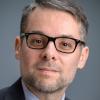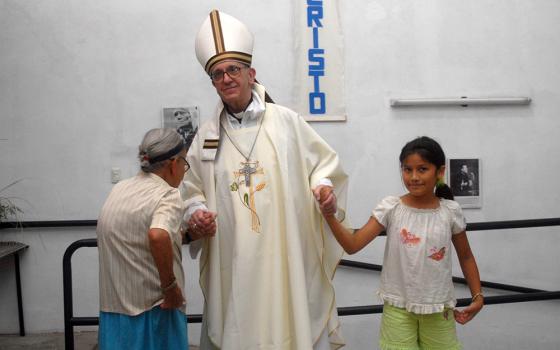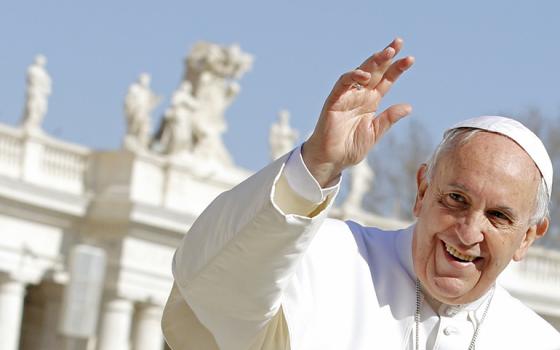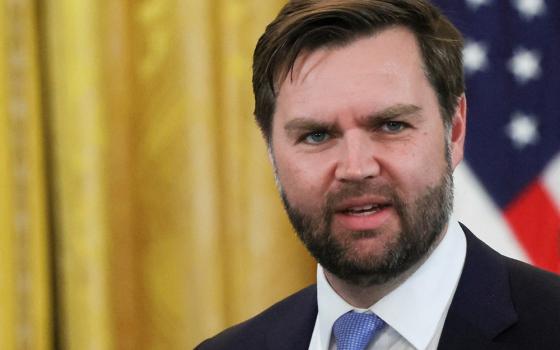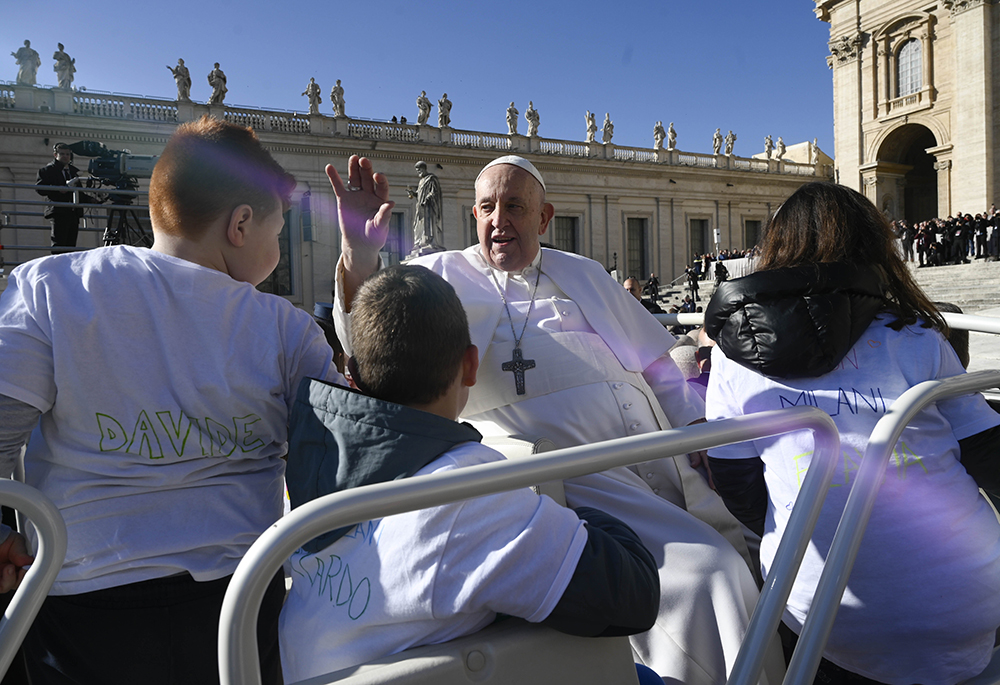
Pope Francis greets the crowd in St. Peter's Square at the Vatican while riding in the popemobile with a group of children before his general audience March 15, 2023. Pope Francis, formerly Argentine Cardinal Jorge Mario Bergoglio, died April 21, 2025, at age 88. (CNS/Vatican Media)
Pope Francis' pontificate should not be measured in time, but in the theological, ecclesial and emotional intensity since its phenomenal start in an extraordinary situation of coexistence with his predecessor, "pope emeritus" Benedict XVI.
Those who have followed Francis' pontificate have been changed by it in ways that will take time to absorb adequately, given the amount of energy given to the global Catholic Church by the former Argentine Cardinal Jorge Mario Bergoglio. Three major contributions stand out, in my judgment, as integral and distinctive parts of Francis' legacy.
The first is a redefinition of the papal office. The first pope from the Americas and the first (and maybe last) Jesuit pope decided, from his very first few days, to innovate the apparatus around the papal persona — beginning with his decision to renounce the papal apartment and to live in the Casa Santa Marta, the Vatican's guest hotel.
This "street priest" who had been elected pope kept at a distance the prefecture of the papal household (also because its prefect remained the private secretary of the "pope emeritus" Benedict XVI, creating a conflict of commitment if not of interest). Giving up the appartamento was much more than a real estate decision. This had the effect to desacralize the papal apparatus in the direction of an aggiornamento of the most visible symbol of Catholicism.
This also was meant to create a direct connection with the people across the world, which was really a main part of Francis' ecclesiology. He reached people that had not been reached before, and also did not maintain around him a stable cohort of advisers and gatekeepers, as previous popes had.
Francis' political-theological mystique of "the people" trumped other connections that at the beginning were expected to take shape, for example, with the Diocese of Rome. Francis chose the social and existential margins of the città eterna. In this way, he made institutions that for centuries had been the first circles around the pope — the Vatican Curia, the vicariate for the Diocese of Rome, the clergy of Rome — feel marginalized.
He reached people that had not been reached before, and also did not maintain around him a stable cohort of advisers and gatekeepers, as previous popes had.
This effort to create a direct connection with the people was carried out through a constant, and sometimes excessive, use of interviews — addressing even the most delicate international and diplomatic issues by bypassing Vatican media structures and surprising his closest collaborators, including inside the Vatican's Secretariat of State.
The pope became more approachable and desacralized, but Francis' reforms (especially the reform of the Roman Curia) risked being overshadowed by a style of teaching and speaking (including the outpouring of books authored, coauthored and prefaced by Francis) that went beyond even the hyper-media-aware papacy of Pope John Paul II. It is not clear what the effect of a Catholicism that is more pope-centered will have on the church in the long term.
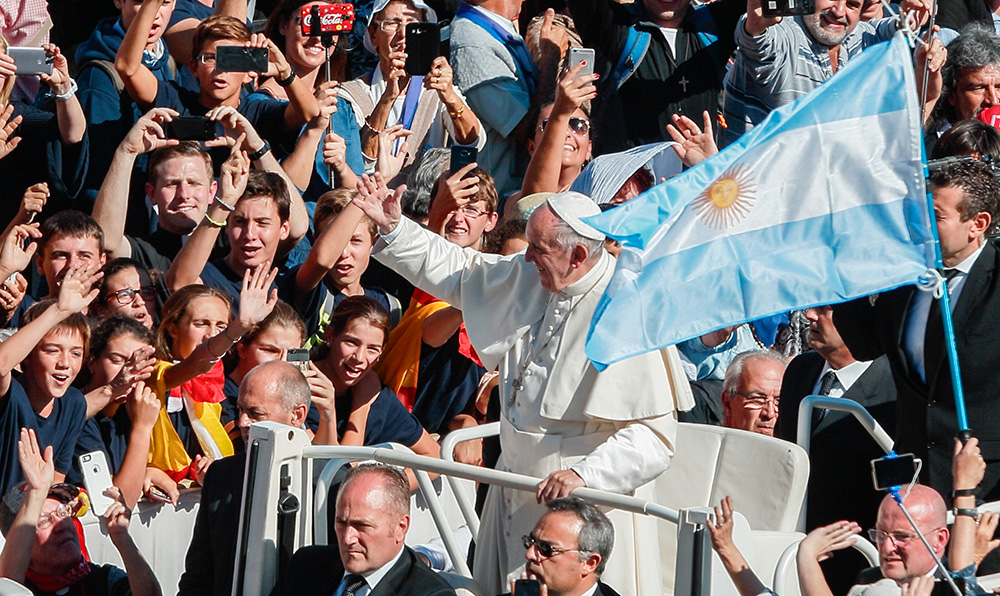
Argentina's flag is seen as Pope Francis greets the crowd after celebrating a canonization Mass for seven new saints in St. Peter's Square at the Vatican Oct. 16, 2016. Among those canonized was Argentine St. José Gabriel del Rosario Brochero, known as the "gaucho priest." (CNS/Paul Haring)
The second major contribution by Francis is the political and geopolitical acceleration given by the pope to the globalization of Catholicism — as a church that does not depend on a Euro-Western matrix and is no longer seeing the continental and local churches as franchises of a brand owned by white males.
The reading of the Gospel from the "Global South" is at the roots of Francis' courageous decoupling of Catholicism from the narrow set of issues imposed by the U.S. "culture wars," and repositioning the Catholic social teaching tradition as front and center of the church's concerns. Under Francis, we have seen the continental drift of global Catholicism — from an idealized, united "Catholic Pangea" to continents more and more distant and distinct. One prime example was the rejection by many African church leaders of the pope's 2023 approval of blessings for same-sex couples, or those in so-called irregular unions.
Under Francis, we have seen the continental drift of global Catholicism — from an idealized, united "Catholic Pangea" to continents more and more distant and distinct.
This acceleration of the globalization of the Catholic Church took place thanks to a Latin American pope with a view of history that sees Latin America — not the old Europe, not the U.S. — as a moment and a place for a new beginning in world history, with Asia on the horizon (much more than Africa).
This is the framework to understand Francis' most controversial political and diplomatic decisions, such as the 2018 agreement with China on the appointments of bishops, and how he first responded to Russia's invasion of Ukraine in February 2022.
Francis opened ways for more diversity in the global church, but this is no guarantee that this more diverse leadership (for example, in the College of Cardinals) will continue on the path opened by Francis. The continental and local churches have forced Rome to acknowledge a new assertiveness backed by massive demographic changes that are changing the face of the Catholic clergy, religious orders, and theologians. Europe and especially Germany have been visibly told to "know their place" in the new globalized Catholicism. This is truly the beginning of the third millennium in church history.
The third major legacy is at the magisterial level. The first Jesuit pope and the first Latin American pope invested, and from the very beginning, a stunningly high amount of his political capital in signaling the priority of the pastoral dimension in church teachings, even on the most divisive issues for Catholicism in the Western hemisphere.
From the "Who am I to judge?" of July 2013 to the 2023 blessings decree on the gay question, to the 2014-15 Synod of Bishops on the family, and to the 2016 apostolic exhortation Amoris Laetitia giving an opening to divorced and remarried Catholics, Francis has privileged the need to show a "big tent" idea of the Catholic Church. For some people, this came at the expense of doctrinal continuity and/or clarity.
Surely, Francis has done all this while keeping distance from academic theology and Catholic intellectuals, privileging other kinds of interlocutors both within the church and outside. Francis has done all this in fidelity to the letter and the spirit of the Second Vatican Council, aware of the limits of the council's documents and the theology supporting them half a century later.
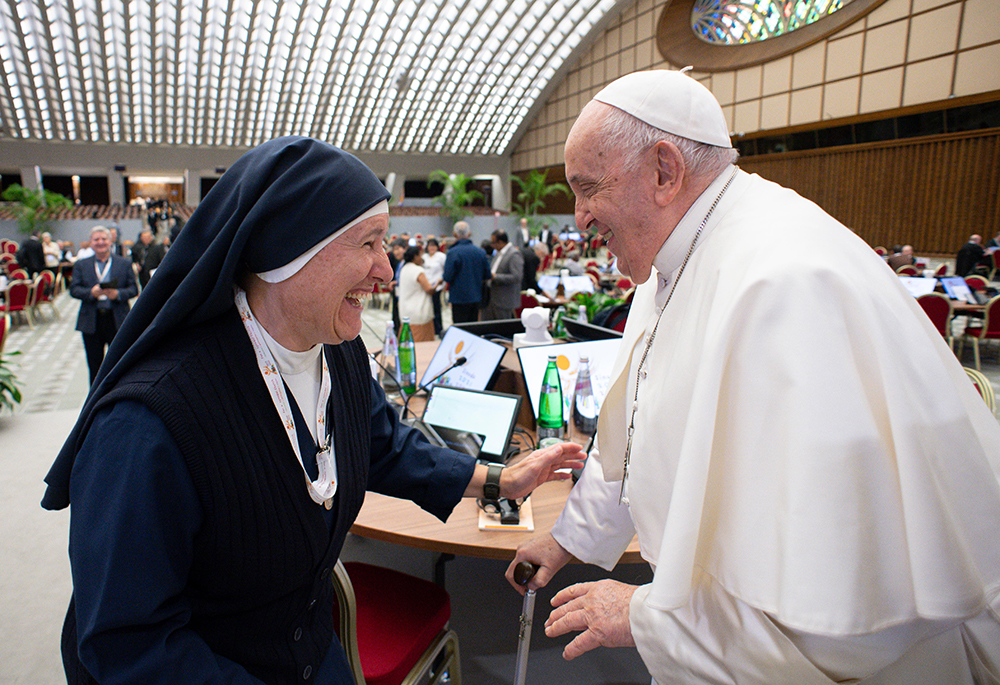
Pope Francis shares a laugh with Canadian Sister Chantal Desmarais, a member of the Sisters of Charity of St. Mary, before a session of the assembly of the Synod of Bishops in the Vatican's Paul VI Audience Hall Oct. 17, 2023. (CNS/Lola Gomez)
That was the unstated goal of the 2021-24 Synod of Bishops on synodality: doing something like a "Vatican III" without formally calling it that, knowing the impossibilities of that enterprise from ecclesial and ecclesiastical points of view. And no one knows whether there will be something like a "Vatican III" ever: the Synod of Bishops on synodality could be the end of two millennia of "conciliar tradition" and the beginning of a more complex "synodal tradition."
But Francis has continued the trajectories of Vatican II — looking for a new balance between law and love, institution and movement, ressourcement and aggiornamento. Advocates of the LGBTQ cause have much to thank him for: Francis is something like the patron saint of the cause for a more welcoming church. For the same reason, other Catholics will try to forget this pontificate as soon as possible — and will try to revert and reverse what has been done on that issue.
Advocates of the LGBTQ cause have much to thank him for: Francis is something like the patron saint of the cause for a more welcoming church.
More difficult is to say how the cause of the inclusion of women in the church will remember Francis: it's more complicated than for his predecessors, who never made promises (not even couched in traditional and patriarchal clerical language, like Francis) on that front. Just like for women in the church, also the relationship between academic theology and Pope Francis is a perfect example of unrequited love: the academic establishment loved him more than Francis loved them. For Catholic theologians, the pope of the church as a "field hospital" was more a distant emancipator than a close interlocutor.
In sum, Francis' papacy was a rebalancing of Benedict XVI's papacy, more than of dramatic steps forward. The paradigm of John Paul II as the pope singlehandedly reshaping Catholicism, and being able to lead the institutional church where he wanted, remains untouched.
But Francis' pontificate coincided with, and understood, the beginning of a new era — an era of a post-European, global Catholicism. It will be difficult for anyone — including the next Bishop of Rome — to ignore what happened thanks to Pope Francis. We will see whether his papacy has been an anomaly or a reset.
